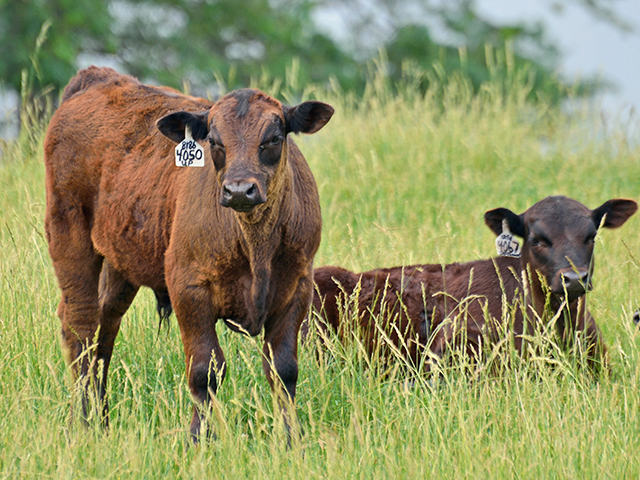Forages Crucial for Good Stocker System
Strategies for Stockers
As drought conditions crippled parts of the High Plains and the West in June, an improved opportunity for stockers was building into the cattle market.
Producers with plenty of forage were considering the benefits of buying lightweight calves and adding pounds on standing forages. It's a decision best made this year with your eyes wide open to the potential challenges, says Kenny Burdine, University of Kentucky livestock marketing and management specialist.
"These calves can be a good buy. When we see early-weaned calves come into stocker operations, the first thing we have to recognize is there is more potential for a higher level of management, and that there will be health problems," he explains.
Balancing those two ends of the spectrum means running the budget to see what the numbers look like. Every operation will be different.
"Pay a lot of attention to the health of the cattle. If they are lighter and higher risk, don't be afraid to do more to manage them on the health side," Burdine says.
WHERE STOCKERS FIT
A good stocker system uses pasture forages during the early spring and fall as the main source of weight gain. That is especially attractive when feed prices are high. It's also a way to make otherwise idle ground profitable.
In Missouri, Extension beef specialist Eric Bailey notes stocker cattle operations can be game changers for producers, as less money is invested in things like grain, hay, equipment or land. Farmers with forage in the spring can run a set of stockers from early February to early July and additional stockers from October to the end of the year if forage quality and quantity hold out.
P[L1] D[0x0] M[300x250] OOP[F] ADUNIT[] T[]
"I am taking a 500-pound calf, and I am hoping to deliver a 700-pound calf who is ready to go into a feedlot," he explains in an analysis. "I am shooting for 100 days. And, I am hopeful that I will put about 200 pounds of weight on them in those 100 days with minimal feed supplements."
MARKET VOLATILITY WORRIES
What about all of today's market volatility? Kentucky's Burdine addressed that in a report he wrote with Greg Halich, professor in farm management economics for the University of Kentucky.
It's important, Burdine says, to look ahead and forward price contract if that is an option. He advises looking at CME feeder cattle futures prices for the projected sale month. A common time frame for stocker sales is October and November.
"If you have stockpiled grass, you may be able to get into November and December," he adds. "As you move further South, stockers can get into that later marketing time frame. Use futures to estimate and manage price."
Earlier this year, Burdine and Halich assessed the likely profitability of a summer stocker program for 2021, establishing target purchase prices for calves based on estimated returns. At that time, they were anticipating sales prices on 750- to 850-pound calves using a CME futures contract price for October 2021 of $157 per cwt. Under this scenario, a 775-pound steer was estimated at a value of $152.50 per cwt, and an 875-pound steer at $146.50 per cwt. Prices were based on the assumption cattle sold in lots of 40 or more head.
Burdine explains if a stocker buys a 500-pound steer and targets $75 gross profit per head, he needs to sell the steer at 775 pounds at $1.525 per pound for a total of $1,182. Estimating variable costs at $141 and deducting a $75 profit puts the target purchase cost for that calf at $966, or $193 per cwt on a 500-pound calf.
"The tendency is for calf prices to reach seasonal price peaks when grass really starts growing in early spring," he notes. "There is little reason to think this won't happen in 2021, which will result in tighter expected margins for stocker cattle during those periods."
Burdine says two factors in 2021 are market-critical. First, there is an unusually large difference between prices for heavy feeder cattle and what the fall board suggested at press time. This disparity led to some stockers bidding less aggressively, likely looking at heavy feeder prices rather than fall expectations.
Second, higher feed costs will probably discourage feedlots from putting lighter-weight calves on feed, holding down competition in calf markets.
Burdine adds that many smaller producers won't have the ability to sell in truckload lots and should consider Livestock Risk Protection (LRP) insurance this season. LRP is a USDA-subsidized insurance product to protect against downside risks by setting a price floor based on national feeder cattle prices. It creates an opportunity to take advantage of market increases; but if national prices fall below where a producer has locked in a floor, it can trigger a payment.
The LRP uses CME feeder cattle futures prices. Coverage periods range from 13 to 52 weeks, and the minimum number of head to participate is just one. Subsidy rates depend on coverage level chosen and how far out the price is contracted.
**
FOR MORE INFORMATION:
-- USDA Livestock Risk Protection: rma.usda.gov/en/RMALocal/State-Map
[PF_0821]
(c) Copyright 2021 DTN, LLC. All rights reserved.



